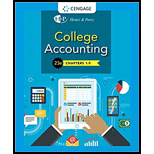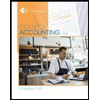
1-(a)
Journalize the entry for the issuance of bonds in the books of Incorporation E.
1-(a)
Explanation of Solution
Bonds: Bonds are the financial debt instruments issued by the corporations to raise capital for the purposes of purchasing assets, or paying debts. Bonds are bought by individual investors, or corporations, or mutual funds, and receive a fixed interest revenue.
Debit and credit rules:
- Debit an increase in asset account, increase in expense account, decrease in liability account, and decrease in
stockholders’ equity accounts. - Credit decrease in asset account, increase in revenue account, increase in liability account, and increase in stockholders’ equity accounts.
Journalize the entry for the issuance of bonds in the books of Incorporation E.
| Date | Account Titles and Explanation | Post Ref. | Debit ($) | Credit ($) | ||
| 20-1 | ||||||
| April | 1 | Cash | 485,000 | |||
| Discount on Bonds Payable | 15,000 | |||||
| Bonds Payable | 500,000 | |||||
| (Record issuance of bonds at discount) | ||||||
Table (1)
Description:
- Cash is an asset account. The amount is increased because cash is received from the bond issue, and an increase in assets should be debited.
- Discount on Bonds Payable account is a contra-liability account, the account which decreases the balance of the respective liability account. Therefore, the respective liability account is decreased, and a decrease in liability is debited.
- Bonds Payable is a liability account. Since the liability to pay bonds has increased, liability increased, and an increase in liability is credited.
Working Notes:
Compute the amount of cash received.
Compute the amount of discount on bonds payable (unamortized discount).
Note: Refer to Equation (1) for value and computation of cash received.
(b)
Journalize the entry for the semiannual interest payment and discount amortization in the books of Incorporation E.
(b)
Explanation of Solution
Journalize the entry for the semiannual interest payment and discount amortization in the books of Incorporation E.
| Date | Account Titles and Explanation | Post Ref. | Debit ($) | Credit ($) | ||
| 20-1 | ||||||
| September | 30 | Bond Interest Expense | 20,375 | |||
| Discount on Bonds Payable | 375 | |||||
| Cash | 20,000 | |||||
| (Record payment of semiannual interest and the amortization of discount) | ||||||
Table (2)
Description:
- Bond Interest Expense is an expense account. Expenses reduce the stockholders’ equity account, and a decrease in equity is debited.
- Discount on Bonds Payable account is a contra-liability account, the account which decreases the balance of the respective liability account. Since the discount is amortized, the discount value is reduced, and a decrease in contra-liability is credited.
- Cash is an asset account. The amount is decreased because cash is paid, and a decrease in assets should be credited.
Working Notes:
Compute the cash paid.
Compute the amount of amortized discount.
Note: Refer to Equation (2) for value and computation of unamortized discount.
Compute the amount of bond interest expense.
Note: Refer to Equation (3) and (4) for both the values.
(c)
Journalize the entry for the year-end adjustment in the books of Incorporation E.
(c)
Explanation of Solution
Journalize the entry for the year-end adjustment in the books of Incorporation E.
| Date | Account Titles and Explanation | Post Ref. | Debit ($) | Credit ($) | ||
| 20-1 | ||||||
| December | 31 | Bond Interest Expense | 10,187.50 | |||
| Discount on Bonds Payable | 187.50 | |||||
| Bond Interest Payable | 10,000.00 | |||||
| (Record interest expense accrued) | ||||||
Table (3)
Description:
- Bond Interest Expense is an expense account. Since the interest is accrued, the interest expense increased. Expenses reduce the stockholders’ equity account, and a decrease in equity is debited.
- Discount on Bonds Payable account is a contra-liability account, the account which decreases the balance of the respective liability account. Since the discount is amortized, the discount value is reduced, and a decrease in contra-liability is credited.
- Bond Interest Payable is a liability account. Since the liability to pay interest has increased, liability increased, and an increase in liability is credited.
Working Notes:
Compute the accrued bond interest payable amount.
Compute the amount of amortized discount.
Note: Refer to Equation (2) for value and computation of unamortized discount.
Compute the amount of bond interest expense.
Note: Refer to Equation (6) and (7) for both the values.
(d)
Journalize the entry to reverse the year-end adjustment in the books of Incorporation E.
(d)
Explanation of Solution
Journalize the entry to reverse the year-end adjustment in the books of Incorporation E.
| Date | Account Titles and Explanation | Post Ref. | Debit ($) | Credit ($) | ||
| 20-2 | ||||||
| January | 1 | Bond Interest Payable | 10,000.00 | |||
| Discount on Bonds Payable | 187.50 | |||||
| Bond Interest Expense | 10,187.50 | |||||
| (Record reversing entry for the accrued interest expense) | ||||||
Table (4)
Description:
- Bond Interest Payable is a liability account. Since the entry is reversed, liability which was credited earlier is debited now.
- Discount on Bonds Payable account is a contra-liability account, the account which decreases the balance of the respective liability account. Since the entry is reversed, the liability which was credited earlier is debited now.
- Bond Interest Expense is an expense account. Since the entry is reversed, the stockholders’ equity which was debited earlier is credited now.
Note: Refer to Equations (6), (7), and (8) for the computation of all values.
(e)
Journalize the entry for the semiannual interest payment and discount amortization for 20-2, in the books of Incorporation E.
(e)
Explanation of Solution
Journalize the entry for the semiannual interest payment and discount amortization in the books of Incorporation E, on September 30.
| Date | Account Titles and Explanation | Post Ref. | Debit ($) | Credit ($) | ||
| 20-2 | ||||||
| September | 30 | Bond Interest Expense | 20,375 | |||
| Discount on Bonds Payable | 375 | |||||
| Cash | 20,000 | |||||
| (Record payment of semiannual interest and the amortization of discount) | ||||||
Table (5)
Description:
- Bond Interest Expense is an expense account. Expenses reduce the stockholders’ equity account, and a decrease in equity is debited.
- Discount on Bonds Payable account is a contra-liability account, the account which decreases the balance of the respective liability account. Since the discount is amortized, the discount value is reduced, and a decrease in contra-liability is credited.
- Cash is an asset account. The amount is decreased because cash is paid, and a decrease in assets should be credited.
Note: Refer to Equations (3), (4), and (5) for both the values.
Journalize the entry for the semiannual interest payment and discount amortization in the books of Incorporation E, on March 31.
| Date | Account Titles and Explanation | Post Ref. | Debit ($) | Credit ($) | ||
| 20-2 | ||||||
| March | 31 | Bond Interest Expense | 20,375 | |||
| Discount on Bonds Payable | 375 | |||||
| Cash | 20,000 | |||||
| (Record payment of semiannual interest and the amortization of discount) | ||||||
Table (6)
Description:
- Bond Interest Expense is an expense account. Expenses reduce the stockholders’ equity account, and a decrease in equity is debited.
- Discount on Bonds Payable account is a contra-liability account, the account which decreases the balance of the respective liability account. Since the discount is amortized, the discount value is reduced, and a decrease in contra-liability is credited.
- Cash is an asset account. The amount is decreased because cash is paid, and a decrease in assets should be credited.
Note: Refer to Equations (3), (4), and (5) for both the values.
2.
Compute the amount of carrying value of the bonds on September 30, 20-2.
2.
Explanation of Solution
Carrying value: The carrying value of a bond is the sum of face value and the unamortized premium or the difference between the face value and the amortized discount. This is the value that is recorded on the
Prepare a bond discount amortization schedule to compute the amount of carrying value of the bonds on September 30, 20-2.
| Date |
Interest Expense Debit (1) |
Discount on Bonds Payable Credit (2) |
Cash Credit (3) |
Bonds Payable Balance (4) |
Discount on Bonds Payable (5) |
Carrying Value of Bonds (6) |
| 4/01/-1 | $500,000 | $15,000 | $485,000 | |||
| 9/30/-1 | $20,375 | $375 | $20,000 | 500,000 | 14,625 | 485,375 |
| 3/31/-2 | 20,375 | 375 | 20,000 | 500,000 | 14,250 | 485,750 |
| 9/30/-2 | 20,375 | 375 | 20,000 | 500,000 | 13,875 | $486,125 |
Table (7)
Note: Refer to Requirement (1) for the computation of all values.
Thus, the amount of carrying value of the bonds on September 30, 20-2 is $486,125.
Want to see more full solutions like this?
Chapter 22 Solutions
COLLEGE ACCT.,CH.1-9-W/CENGAGENOW2
- The actual cost of direct labor per hour is $16.25 and the standard cost of direct labor per hour is $15.00. The direct labor hours allowed per finished unit is 0.60 hours. During the current period, 4,500 units of finished goods were produced using 2,900 direct labor hours. How much is the direct labor rate variance? A. $3,625 favorable B. $3,625 unfavorable C. $4,350 favorable D. $4,350 unfavorablearrow_forwardOn January 1 of the current year, Piper Company issues a 4-year, non-interest-bearing note with a face value of $8,000 and receives $4,952 in exchange. The recording of the issuance of the note includes a: a. credit to Notes Payable for $4,952. b. credit to Discount on Notes Payable for $3,048. c. debit to Discount on Notes Payable for $3,048. d. debit to Cash for $8,000.arrow_forwardPLease helparrow_forward
- What is the budgeted total cost of direct materials purchases?arrow_forwardHy expert provide answer with calculationarrow_forwardDuring September, the assembly department completed 10,500 units of a product that had a standard materials cost of 3.0 square feet per unit at $2.40 per square foot. The actual materials purchased consisted of 22,000 square feet at $2.60 per square foot, for a total cost of $57,200. The actual material used during this period was 25,500 square feet. Compute the materials price variance and materials usage variance.arrow_forward
- Bluesy Electronics recorded the following financial data: Net Sales $720,500 Average Inventory at Cost = $80,200 Gross Margin Percentage = 42% Calculate the GMROI.arrow_forwardNeed help this question solutionarrow_forwardXYZ Company has a gross profit margin of 0.30, an operating profit margin of 18%, a total asset turnover ratio of 2.0x, and cost of goods sold of $700,000. The company's tax rate is 35%, and it has no debt. Calculate XYZ Company's Return on Assets (ROA).arrow_forward
 College Accounting, Chapters 1-27AccountingISBN:9781337794756Author:HEINTZ, James A.Publisher:Cengage Learning,
College Accounting, Chapters 1-27AccountingISBN:9781337794756Author:HEINTZ, James A.Publisher:Cengage Learning, Financial AccountingAccountingISBN:9781337272124Author:Carl Warren, James M. Reeve, Jonathan DuchacPublisher:Cengage LearningPrinciples of Accounting Volume 1AccountingISBN:9781947172685Author:OpenStaxPublisher:OpenStax College
Financial AccountingAccountingISBN:9781337272124Author:Carl Warren, James M. Reeve, Jonathan DuchacPublisher:Cengage LearningPrinciples of Accounting Volume 1AccountingISBN:9781947172685Author:OpenStaxPublisher:OpenStax College Excel Applications for Accounting PrinciplesAccountingISBN:9781111581565Author:Gaylord N. SmithPublisher:Cengage Learning
Excel Applications for Accounting PrinciplesAccountingISBN:9781111581565Author:Gaylord N. SmithPublisher:Cengage Learning College Accounting, Chapters 1-27 (New in Account...AccountingISBN:9781305666160Author:James A. Heintz, Robert W. ParryPublisher:Cengage LearningCentury 21 Accounting Multicolumn JournalAccountingISBN:9781337679503Author:GilbertsonPublisher:Cengage
College Accounting, Chapters 1-27 (New in Account...AccountingISBN:9781305666160Author:James A. Heintz, Robert W. ParryPublisher:Cengage LearningCentury 21 Accounting Multicolumn JournalAccountingISBN:9781337679503Author:GilbertsonPublisher:Cengage





